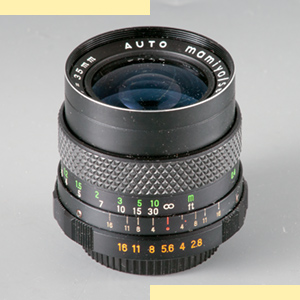The Mamiya Sekor SX 2.8/35mm is a moderate wideangle lens for the Mamiya DSX and MSX series of M42 SLRs. Interestingly the lens uses an optical scheme consiting of a Tessar type master lens ad a three lens wide angle converter in front of it. While such constructions were state-of-the-art in the 1950s and early 1960s, they clearly were outdated around 1974 when the Mamiya SX 2.8/35mm was introduced. The lens therefore has the typical weaknesses of such lenses, mainly coma and astigmatism.
 |
MAMIYA SEKOR SX 35mm 1:2.8 (7 Linsen / 5 Glieder)
|
|
The lens barrel of the Sekor SX 2.8/35mm is well built, and made completely from metal. Focusing is rather stiff (as with all other Sekor SX lenses I own), and the MFD is 0.4m. The aperture ring is nicely built - large enough and with its own corrugated grip. Apertures can be set in half-stops from 2.8 to 11, and in full stop from 11 to f16.
Given that it is an "old scool" wideangle design, the lens performs relatively well at f2.8. While the central part (approximately the size of the APS-C sensor) is sharp and well defined without obvious CAs, the outer part of the images suffers from astigmatism, coma and some CAs. That said, other (older) 2.8/35mm often perform worse (e. g. Konica AR 2.8/35mm "metal grip"). However, more modern constructions such as the Minolta MC-X 2.8/35 [5/5] would appear just one year later, and they are much better than the Mamiya SX shown here. Mamiya was aware of this, and their later CS 2.8/35mm (about 1977) for the NC1000 SLR was a modern construction with excellent performance.


